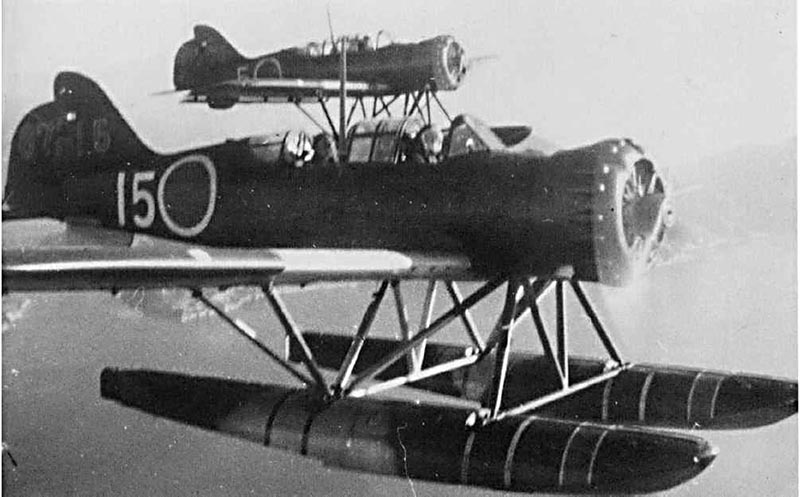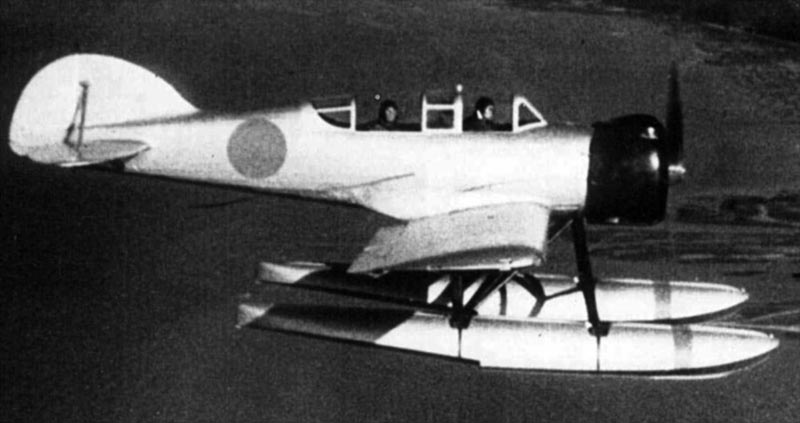During WWII, man brought home Japanese bomb in the glovebox
Civilian volunteers retrieved debris from the Japanese submarine-launched seaplane bombing of the forest near Brookings —including an intact, unexploded bomb. Only later did they realize how lucky they were that it really was a dud.
EDITOR'S NOTE: A revised, updated and expanded version of this story was published in 2024 and is recommended in preference to this older one. To read it, click here.

Two Yokosuka E14Y Type Zero reconnaissance seaplanes -- the type was
known to Allied air crews as "Glen" -- in flight. This is the aircraft type
that dropped the bombs on Oregon, after being launched from the
Japanese submarine I-25, with Nobuo Fujita at the controls.
By Finn J.D. John — July 10, 2009
In September 1942, a tiny Japanese seaplane launched from a submarine conducted the only air raid on the mainland U.S. in history.
And but for the intervention of some good luck, it might have succeeded in killing three Oregonians.
Pilot Nobuo Fujita hadn’t planned to kill anybody directly. He was flying a tiny, rickety seaplane that a kid with a .22 rifle could have shot down. His goal was to set the great Oregon forests alight and get back to the submarine alive.
So, very early on the morning of Sept. 9, avoiding human eyes as much as possible, the tiny plane buzzed over Brookings, found a nice woodsy spot around nearby Mount Emily, dropped a pair of 170-pound incendiaries on it, and scurried back to the sub. A few days later it came back on a second run near Cape Blanco.

A prototype of the E14Y in flight, before the war broke out. This early
version had a different rudder configuration. (Image: Government of Japan)
Fortunately for nearby residents, the fire season had largely ended by that time, and the fires Fujita lit were quickly stamped out. The fact that everything was still soaked with morning dew helped as well – every Oregon logger knows you’re a lot less likely to have trouble with fire at 6:24 a.m. than at, say, 4 p.m.
But it was in the process of cleaning up after the second bombing run that the Japanese came closest to claiming a trio of victims.
An Oregon Department of Forestry engineer named Louis Amort happened to be in the area with two co-workers when he heard the report of the bombing, and they hurried to the scene to offer their services in putting out any fires.
One of the bombs had failed to explode. Bits of the other were scattered all over the place.
The three of them immediately got busy picking up bits of bomb to turn over to the Army. Speaking 48 years later to Salem Statesman Journal reporter Hank Arends, Amort said they “picked them up and put them in a paper sack or wrapped them in a blanket and put them in the glove box.”
Amort told local historian and Brookings bombing expert Bill McCash that this included bits of unexploded bomb three inches in diameter and 10 to 12 inches long. (Whatever Amort and his colleagues were driving must have had a pretty big glovebox.)
Then they drove through the very bumpy terrain around the bomb site back to town, where they turned the bits of unexploded TNT over to an Army liaison officer.
Presumably, the Army officer handled them with greater care than Amort and his friends, who only afterward realized what an enormous risk they’d just taken by stuffing a live firebomb in their glove compartment.
(Sources: McCash, William. Bombs Over Brookings. Bend, Ore.: Maverick, 2005; Arends, Hank. “Salem man recalls Japanese bombing,” Salem Statesman Journal, May 14, 1990)
-30-











